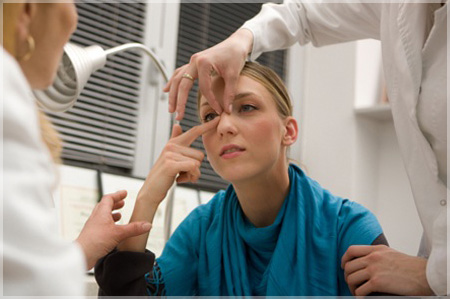
1. Endoscopic Repair of C.S.F Rhinorrhoea:
CSF rhinorhoea is defined as the leakage of CSF from the nose due to communication with the subarachnoid space. With the alarming rise in road traffic accidents, the incidence of CSF rhinorrhoea has greatly increased. Trauma comprises 80-90% of CSF leaks followed by iatrogenic leaks 10-16% and non-traumatic spontaneous leaks .CSF rhinorrhea may occur directly through the anterior cranial fossa or indirectly from the middle or posterior fossa via the Eustachian tube. More specifically, these portals of entry may take place across the frontal sinus, cribriform plate of the ethmoid, the sphenoid sinus, the sella, or via the temporal bone from the middle ear and through the Eustachian tube.
2. Fess For Sinusitis:
Functional endoscopic sinus surgery (FESS) is the mainstay in the surgical treatment of sinusitis and nasal polyps, including bacterial, fungal, recurrent acute, and chronic sinus problems. Ample research supports its record of safety and success.
FESS is a relatively recent surgical procedure that uses nasal endoscopes (using Hopkins rod lens technology) through the nostrils to avoid cutting the skin. These endoscopes have diameters of 4mm (adult use) and 2.7mm (pediatric use) and come in varying angles of view from 0 degrees to 30, 45, 70, 90, and 120 degrees. They provide good illumination of the inside of the nasal cavity and sinuses.
3. Endoscopic Surgery for Nasal Polyposis, Tumour, Fungal Rhinosinusitis
4. Septoplasty:
Septoplasty is a corrective surgical procedure done to straighten the nasal septum, the partition between the two nasal cavities. Ideally, the septum should run down the center of the nose. When it deviates into one of the cavities, it narrows that cavity and impedes airflow. Often the inferior turbinate on the opposite side enlarges, which is termed compensatory hypertrophy. Deviations of the septum can lead to nasal obstruction. Most surgeries are completed in 60 minutes or less, not including recovery time.
5. Rhinoplasty:
Rhinoplasty a nose job, is a plastic surgery procedure for correcting and reconstructing the form, restoring the functions, and aesthetically enhancing the nose, by resolving nasal trauma (blunt, penetrating, blast), congenital defect, respiratory impediment, and a failed primary rhinoplasty.
Historically, surgical rhinoplasty was first developed in antiquity, while non-surgical rhinoplasty, a non-invasive method involving injections, was developed in modern times.
6. Surgery for Sino-Nasal Mass:
A diverse group of pathologic findings requires surgical excision from the sinonasal tract. Symptoms directly related to pathologic findings, pending complications and the possibility or suspicion of malignancy, should be the cornerstones of surgical decision making. The management of benign sinonasal masses should follow a balanced algorithm to weigh the need for resection against the adverse effects of surgical removal. Endoscopic approaches have become the primary modality by which most benign masses of the nasal cavity and sinuses are managed. This article describes an aggressive surgical approach to these lesions while maintaining respect for their benign nature and the importance of preserving natural barriers to growth (spread), such as the dura and periorbita.
7. Faciomaxillary Trauma Surgery (Faciomaxillary):
Various treatment modalities for panfacial fracture management are conservative with splints, closed reduction, external fixators, open reduction with internal fixation using screws and plates, bone grafts etc. Surgical repair of maxillofacial trauma requires modification of the standard anaesthesia techniques. Oral, nasal intubation and tracheostomy is the established method for the management of airway. But most of the time oral intubation not possible if dental occlusion is surgical necessity, nasal intubation is contraindicated because of associated Leforte's fractures, and tracheostomy is not preferred because of its complications. So we were in search of other ways to manage the airway. Mode of intubation in such cases is a controversial issue. Submental intubation has solved the problem. Submental intubation is an useful alternative to tracheostomy with minimal complications in these conditions. This technique does not compromise the airway.
8. Surgery for Nasopharyngeal Mass:
Nasopharyngeal masses in adults present a perplexing problem because of the concern for malignancy. A retrospective review of the records, radiographs and biopsy histology of 57 patients presenting in one year with nasopharyngeal masses at the Massachusetts Eye and Ear Infirmary suggests that persistent pain, epistaxis, trismus, or cervical mass are uncommon in patients with benign histology and should alert the clinician to the probability of malignancy. A high index of suspicion on the part of the clinician is essential for the successful recognition of early lesions. The roles of conventional radiography, polytomography, and computed tomography scans are discussed. Patients with malignant lesions are contrasted with those having benign lesions. |